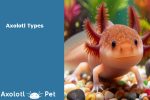Axolotl Care
Axolotl care is essential for ensuring the health and well-being of these unique amphibians, which are often kept as pets by beginners and experienced aquarists alike.
These captivating creatures, which are a type of salamander native to Lake Xochimilco in Mexico, have specific needs that must be met to thrive in captivity.
Understanding proper tank setup is crucial, as it involves choosing the right size tank, incorporating live plants, and ensuring an appropriate environment with a water test kit to monitor conditions.
A well-structured care sheet can help owners keep track of key aspects of axolotl care, including feeding practices involving brine shrimp and feeder fish, as well as important considerations for maintaining water quality by removing chlorine and quarantining new additions.
The lifespan of axolotls can reach up to 15 years or more, making it essential for pet owners to commit to proper care over the long term.
While the difficulty of caring for axolotls varies, with some finding the process straightforward and others requiring more effort, dedicated breeders and pet stores can provide valuable resources and guidance.
For those looking to enhance their axolotl care experience, a printable sheet can serve as a handy reference, covering everything from dietary needs to the potential of undergoing metamorphosis.
With the right knowledge and tools, axolotl enthusiasts can create a thriving habitat that nurtures these extraordinary amphibians.
To ensure effective axolotl care, beginners should seek a comprehensive care sheet, including a printable version, while considering tank setup with live plants.
It’s important to understand that axolotls can nip at each other, and their difficulty in captivity varies, impacting their lifespan.
They should purchase from reputable breeders or pet stores, quarantine new arrivals, and utilize a water test kit to remove chlorine and maintain optimal conditions for these unique amphibians from Lake Xochimilco.
For those interested, there are also options for sale of axolotls and supplies.
Axolotl Care: Stages of Life
1.) Egg Stage
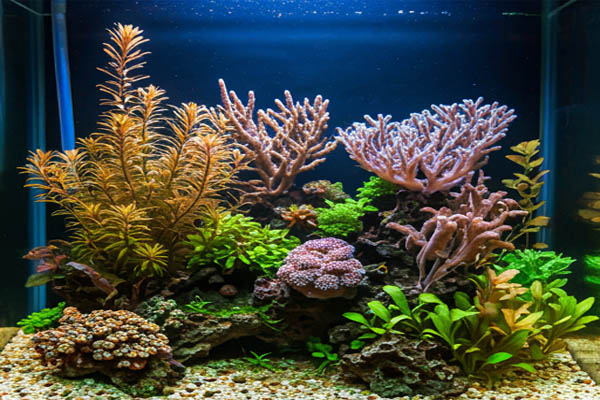
In axolotl care, the egg stage is foundational, as it marks the beginning of the axolotl’s life cycle.
Female axolotls lay eggs, which are small, jelly-like spheres that require consistent water conditions to develop healthily.
During this stage, it’s crucial to keep the tank environment stable, with gentle water flow to prevent disturbing the eggs.
High water quality, a controlled temperature, and protection from potential tank mates are all essential factors to support successful development until hatching.
2.) Mini and Dwarf Axolotls

After hatching, young axolotls enter the mini stage, where they are especially delicate and require careful attention.
At this stage, they need small, frequent meals of protein-rich foods, such as baby brine shrimp, and a well-maintained environment with clean, stable water to ensure proper growth.
Some axolotls may remain smaller due to genetic factors or environmental conditions, classifying them as dwarf axolotls.
Dwarf axolotls require similar care to their larger counterparts but may need even more attentive monitoring to meet their unique growth and health requirements.
In axolotl care, adapting to each of these stages is vital to fostering a healthy, thriving axolotl.
Axolotl Care: Housing and Tank Requirements
Creating an ideal habitat is central to axolotl care, as these aquatic animals need specific tank conditions for their health and well-being.
From the aquarium setup to substrate choice, each component plays a role in providing a safe and comfortable environment.
1.) The Aquarium

In axolotl care, the aquarium should be spacious enough to allow for comfortable movement, with a minimum of 20 gallons recommended for one adult axolotl.
A larger tank helps maintain stable water conditions and gives the axolotl ample room to explore.
It’s important to choose a low-flow filter to avoid stress caused by strong currents, which axolotls are sensitive to.
2.) Substrate

Selecting the right substrate is essential in axolotl care.
Sand is often recommended over gravel, as axolotls may accidentally ingest small particles, which can lead to health issues like impaction.
Bare-bottom tanks are also an option, allowing for easier cleaning, though they may reduce traction for the axolotl to move around comfortably.
3.) Habitat
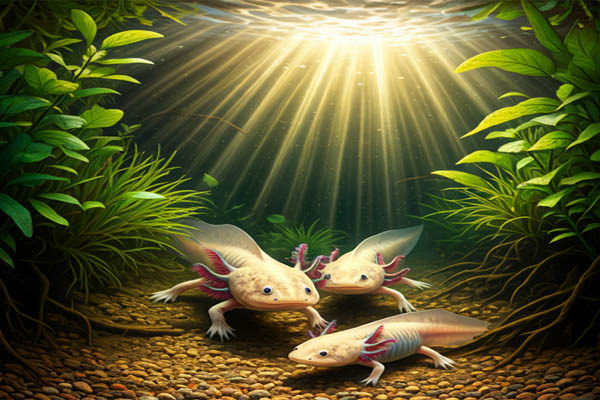
Axolotls thrive in habitats that mimic their natural environments.
Providing hiding spots is a key element of axolotl care, as they enjoy having shaded areas where they can retreat.
Rocks, caves, and PVC pipes can make great shelters, but it’s essential to avoid sharp or rough edges that could injure the axolotl’s delicate skin.
4.) Decor
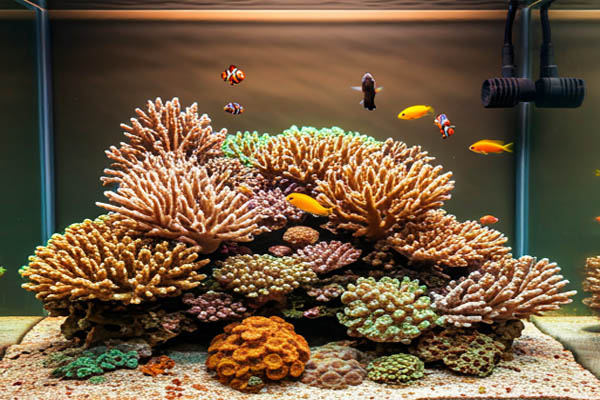
Decor adds enrichment to axolotl care, encouraging natural behaviors.
Opt for smooth decorations and avoid items that could scratch or harm the axolotl.
Natural decor elements, such as driftwood and rock formations, help create a visually appealing environment while providing added interest for the axolotl.
5.) Plants
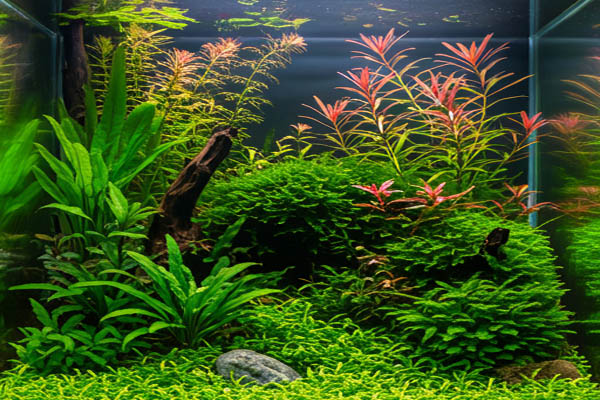
Plants play a beneficial role in axolotl care, as they can improve water quality by absorbing nitrates and provide extra hiding spots.
Live plants like Java fern and Anubias are popular choices, as they thrive in low light and are safe for axolotls.
Artificial plants can also be used, provided they are soft and won’t damage the axolotl’s sensitive skin.
Each of these components contributes to an environment that supports healthy axolotl care by ensuring safety, cleanliness, and enrichment within the tank.
Axolotl Care: Water Parameters and Temperature
Proper water parameters and temperature are essential elements in axolotl care, directly impacting their health and longevity.
From cycling the aquarium to maintaining optimal temperature, each step helps create a stable and safe environment for axolotls.
1.) Cycling Your Aquarium
Before introducing an axolotl, cycling the aquarium is a vital process in axolotl care that establishes beneficial bacteria in the tank.
This bacteria helps break down harmful ammonia and nitrites, creating a safer environment.
Proper cycling typically takes several weeks, and it’s important to test water frequently to ensure safe levels for ammonia, nitrites, and nitrates before adding an axolotl.
2.) Weekly Water Changes
Regular water changes are key to maintaining water quality, an important aspect of axolotl care.
Replacing 20-30% of the tank’s water weekly helps control nitrate levels and reduces the buildup of waste products.
Be sure to use dechlorinated water for refills to avoid exposing axolotls to harmful chemicals.
3.) Water Conditioner
A water conditioner is essential in axolotl care to neutralize chlorine, chloramines, and heavy metals in tap water that could otherwise harm the axolotl.
Adding a suitable water conditioner to any new water entering the tank ensures a safe environment, supporting their sensitive skin and overall health.
4.) Water Quality
Maintaining high water quality is fundamental to axolotl care.
Parameters like pH, ammonia, nitrites, and nitrates should be monitored closely, with pH levels ideally kept between 6.5 and 7.5.
Consistent water quality helps prevent stress and health issues, creating a stable living environment that meets an axolotl’s specific needs.
5.) Temperature Management
Temperature control is crucial in axolotl care, as axolotls thrive in cooler water.
The ideal temperature range is between 60-64°F (16-18°C), as warmer water can increase stress and lead to illness.
Using an aquarium thermometer helps monitor temperature consistently, and if necessary, a chiller or fan can be added to maintain the optimal range.
Each of these water management practices forms the foundation of effective axolotl care, ensuring that their environment remains stable, clean, and supportive of their unique requirements.
Axolotl Care: Testing Water Frequently and Temperature Management
In axolotl care, testing water regularly and managing tank temperature are essential practices that help prevent health issues and maintain a safe environment for axolotls.
By keeping a close watch on these aspects, you can quickly address any changes that might impact their well-being.
1.) Test Your Water Frequently!
Frequent water testing is a crucial step in axolotl care to ensure the water parameters remain within safe limits.
Using an aquarium test kit, monitor ammonia, nitrites, nitrates, and pH levels weekly or more often if needed.
Stable parameters not only promote axolotl health but also help reduce stress, which can contribute to a longer, healthier life.
2.) Temperature Management
Temperature is a significant factor in axolotl care, as they require cooler water to thrive.
Monitoring temperature regularly with an aquarium thermometer helps maintain it in the ideal range of 60-64°F (16-18°C).
During warmer months, it may be necessary to use a chiller, aquarium fan, or even frozen water bottles to keep the water cool, as high temperatures can lead to stress and illness.
By regularly testing water quality and managing temperature, you can provide a stable and comfortable environment that is central to effective axolotl care, supporting their health and overall quality of life.
Axolotl Care: Diet
In axolotl care, providing a balanced and nutritious diet is essential to support their health and growth.
Understanding which foods are safe, beneficial, or best avoided ensures your axolotl receives the nourishment they need.
1.) Staple Foods
The foundation of an axolotl’s diet should consist of high-protein foods, such as earthworms, bloodworms, and specially formulated pellets.
These staples are rich in essential nutrients, supporting growth, strength, and overall health.
Earthworms are particularly favored in axolotl care due to their high nutritional value and ease of digestion.
2.) Treats
Occasional treats can add variety and enrichment to axolotl care.
Foods like brine shrimp, blackworms, and certain types of fish, such as small pieces of tilapia, make suitable treats when given in moderation.
It’s important not to overfeed these, as treats should only supplement their primary diet.
3.) Do Not Feed
In axolotl care, certain foods should be strictly avoided due to potential health risks.
Live feeder fish can introduce diseases or parasites, while insects from outdoor environments may carry pesticides or other toxins.
Additionally, avoid processed human foods, as these can disrupt an axolotl’s digestion and negatively impact their health.
By focusing on a balanced diet, incorporating treats carefully, and avoiding unsafe foods, you can ensure that your axolotl’s dietary needs are fully met, contributing to their overall well-being and supporting the essentials of axolotl care.
Axolotl Care: Behavior
Understanding axolotl behavior is an important part of axolotl care, helping owners recognize normal patterns, unique quirks, and signs of potential health issues.
Observing their behavior regularly can provide insights into their comfort and well-being.
1.) General Behavior
Axolotls are generally calm, spending much of their time exploring or resting at the bottom of the tank.
They may swim around occasionally, especially during feeding time.
Observing these gentle, exploratory behaviors is typical in axolotl care and indicates that they are comfortable in their environment.
2.) Fired Up
“Fired up” behavior refers to moments of increased energy, often due to excitement or stimulation, like spotting food.
During these times, axolotls may become more active and swim rapidly around the tank.
This behavior is normal in axolotl care, as long as it’s occasional and not constant, which could indicate stress.
3.) Abnormal Behavior
In axolotl care, abnormal behaviors can signal stress, illness, or discomfort.
Signs to watch for include floating at the surface for extended periods, rapid gill movement, or refusal to eat.
Excessive swimming near the surface or attempts to escape may also indicate that water quality, temperature, or other environmental factors need adjustment.
Monitoring these behavioral cues is essential in axolotl care, helping you respond promptly to their needs and ensuring a healthy, low-stress environment.
Axolotl Care: Determining Sex
Determining the sex of your axolotl is an important aspect of axolotl care, especially for breeding or tankmate considerations.
Knowing the differences between males and females can help you create a harmonious environment and manage breeding effectively.
1.) Males
Male axolotls typically exhibit distinct physical characteristics that aid in identification.
During the breeding season, males develop a more pronounced cloaca, which becomes swollen and bulbous.
They also tend to have slimmer, more streamlined bodies and can be more active and aggressive than females.
Observing these traits can assist in identifying males, which is crucial for proper axolotl care, particularly in breeding situations.
2.) Females
In contrast, female axolotls generally have broader, rounder bodies, especially when they are full of eggs.
Their cloaca appears flatter and less pronounced than that of males. Females often exhibit a calmer demeanor and may be less territorial.
Recognizing these characteristics is vital in axolotl care, as it allows for better management of their environment and social interactions.
Understanding the differences in male and female axolotls is essential in axolotl care, aiding in appropriate housing, breeding decisions, and overall tank management to ensure the health and happiness of your pets.
Axolotl Care: Tank Mates
Choosing appropriate tank mates is a crucial aspect of axolotl care, as it can significantly affect the health and well-being of your axolotls.
Understanding compatible species, potential risks, and how to prevent breeding can help create a harmonious aquarium environment.
1.) Other Axolotls
Keeping multiple axolotls together can be rewarding, but it’s important to consider their compatibility.
In axolotl care, introducing axolotls of similar size and age can minimize the risk of aggression or bullying.
However, be cautious of gender combinations, as having multiple males in a confined space can lead to territorial disputes.
Ensuring ample space and hiding spots can help reduce stress and conflicts among axolotls.
2.) Risk of Injury
In axolotl care, there is always a risk of injury when housing multiple axolotls together, especially if one is significantly larger or more aggressive than the others.
Injuries can occur from biting or excessive chasing, which may lead to stress or infections.
Monitoring interactions closely and being prepared to separate individuals if necessary is vital for maintaining a safe and healthy environment.
3.) Accidental Breeding
If housing both male and female axolotls, be aware of the possibility of accidental breeding.
In axolotl care, breeding can occur even in the absence of intention, leading to a sudden influx of eggs.
If you do not plan to breed, consider keeping only one gender or providing separate tanks for males and females to prevent unintended breeding.
4.) Shrimp
Some aquarists consider adding shrimp as tank mates for axolotls, but caution is warranted.
While certain types of shrimp, like ghost shrimp, may coexist peacefully with axolotls, they can become prey.
In axolotl care, ensuring that tank mates are appropriately sized and compatible is essential to prevent stress or loss of life among the inhabitants.
By carefully selecting tank mates and monitoring interactions, you can ensure a stable and peaceful environment, enhancing the overall axolotl care experience for both you and your aquatic companions.
Axolotl Care Sheet Printable
You can downlod our Axolotl Care Sheet Printable and use it as your handbook.
Axolotl Care: Closing Thoughts
Axolotl care is a unique part of fishkeeping, especially as these exotic pets are members of the mole salamander family and retain juvenile traits, a phenomenon called neoteny.
Native to Lake Chalco in the Valley of Mexico, near Mexico City, axolotls are now classified as an endangered species.
As a result, providing the right environment in captivity is essential.
Axolotls need a stable freshwater habitat, with a pH between 6.5 and 8.
A gentle sponge aquarium filter is recommended for soft filtration without disrupting the substrate, as high currents can stress axolotls.
Regularly testing water quality, such as with API kits, keeps the environment free of harmful chemical substances.
In terms of diet, axolotls thrive on live food like small worms and chironomidae larvae.
Small amounts of beef can be offered sparingly, though live food is generally better suited for their nutritional needs.
For added comfort, some owners use aquarium-safe aloe vera for skin support.
Tank conditions should mimic their natural habitat; dim lighting works best since axolotls are nocturnal and need low-light environments.
Using fine grain size substrate reduces the risk of ingestion and digestive issues.
Acclimatizing a new axolotl by floating it in a plastic bag within the tank allows it to adjust gradually to its new conditions.
With careful acclimatization, diet, and water maintenance, axolotls can thrive, allowing owners to enjoy these fascinating aquatic pets in a safe and supportive environment.
Axolotl care involves creating a safe environment free from predation, despite their similarities to reptiles; these unique creatures require specific minerals in their water for optimal health, which supports the regeneration of their heart and tail


